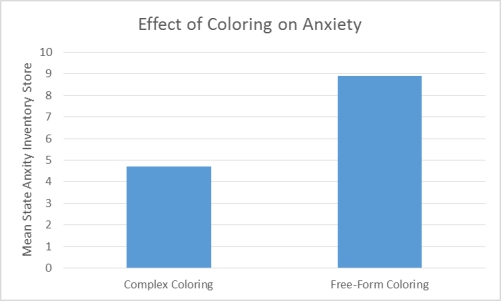Use the following to answer questions
Scenario I
Scenario I is based on fabricated data inspired by the following study:
Curry, N. A. & Kasser, T. (2005) . Can coloring mandalas reduce anxiety? Art Therapy: Journal of American Art Therapy Association, 22(2) 81-85.
Effect of Coloring on Anxiety
Curry and Kasser were interested in examining whether coloring complex geometric patterns reduces anxiety. To that end, they induced anxiety in 84 undergraduate volunteers from their university. Following anxiety induction the participants were divided into two coloring conditions. To determine which condition each participant would be in the researchers put all of their names in a hat. The first name drawn was placed in group 1, the second name drawn was placed in group 2, the third name drawn was placed in group 1, and so on. Those in the complex geometric coloring condition (group 1) were given a paper with a plaid pattern or the outline of a mandala. Those in the control condition (group 2) were given a blank piece of paper. After 20 minutes of coloring all of the participants completed a self-administered State Anxiety Inventory (SAI) . Lower SAI scores indicate low levels of anxiety whereas higher SAI scores indicate high levels of anxiety. The mean SAI scores of each coloring condition were compared to determine whether the type of coloring one does affects anxiety. The results revealed that those who colored a complex geometric pattern had significantly different levels of anxiety than those who colored on a blank sheet of paper. Curry and Kasser concluded that coloring causes a change in anxiety, but only when coloring requires a certain amount of attention and focus.
Figure 1. Effect of Coloring on Anxiety

-(Scenario I) Had participants in this study been allowed to select whether they wanted to color the mandala, the plaid pattern, or the blank paper, the researchers would have used __________ assignment.
A) random
B) nonrandom
C) quasi-random
D) matched-pair
Correct Answer:
Verified
Q40: If a personality psychologist was interested in
Q41: How would you operationalize the variables in
Q42: Use the following to answer questions
Scenario I
Scenario
Q43: Define covariation and then list three examples
Q44: Use the following to answer questions
Scenario I
Scenario
Q46: Use the following to answer questions
Scenario I
Scenario
Q47: Professor Robinson found that students who sit
Q48: Give an example of an experimental hypothesis
Q49: As a pop-culture expert you have noticed
Q50: Sofia notices that her friends engage in
Unlock this Answer For Free Now!
View this answer and more for free by performing one of the following actions

Scan the QR code to install the App and get 2 free unlocks

Unlock quizzes for free by uploading documents